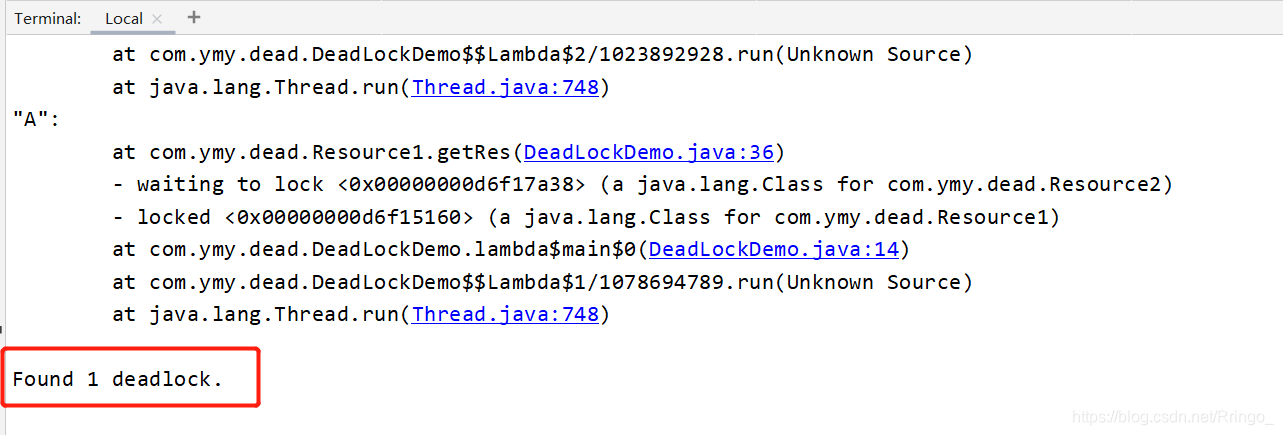1.基础回顾
1.1.什么是JUC?

java.util工具包。
1.2.线程和进程?
进程和线程
进程:一个程序,QQ.exe Music.exe 程序的集合。任务管理里面可以看到进程。一个进程往往可以包含多个线程。
线程:开了一个进程Typora,写字,自动保存(线程负责的)。Java默认有2个线程,main线程和GC守护线程。
对于Java而言,Thread、Runnable、Callable可以创建线程。
Java真的可以开启线程吗??开不了!!!
public synchronized void start() {/*** This method is not invoked for the main method thread or "system"* group threads created/set up by the VM. Any new functionality added* to this method in the future may have to also be added to the VM.** A zero status value corresponds to state "NEW".*/if (threadStatus != 0)throw new IllegalThreadStateException();/* Notify the group that this thread is about to be started* so that it can be added to the group's list of threads* and the group's unstarted count can be decremented. */group.add(this);boolean started = false;try {start0();started = true;} finally {try {if (!started) {group.threadStartFailed(this);}} catch (Throwable ignore) {/* do nothing. If start0 threw a Throwable thenit will be passed up the call stack */}}}// 本地方法,调用Java Native Interfaceprivate native void start0();
1.3.并发和并行
并发:多线程操作同一个资源。单核CPU,模拟出来多条线程,CPU的快速交替。
并行:多个人一起行走。多核CPU,多个线程可以同时执行。可以使用线程池操作。
// 获取CPU的内核数量
System.out.println(Runtime.getRuntime().availableProcessors());
并发编程的本质:充分利用CPU的资源。
1.4.线程有几个状态?
public enum State {
// 新建线程
NEW,
// 运行
RUNNABLE,
// 阻塞
BLOCKED,
// 等待,死等
WAITING,
// 超时等待,过时不候
TIMED_WAITING,
// 终止
TERMINATED;
}
1.5.wait和sleep的区别
1、来自不同的类
wait => Object
sleep => Thread
2、关于锁的释放
wait 会释放锁,sleep 睡觉了,抱着锁睡觉了,不会释放!
3、使用的范围是不同的
wait必须在同步代码块中使用。
sleep可以在任何地方使用。
2.Lock锁
2.1.Synchronized
/**
* 真正的多线程开发,公司中的开发
* 线程就是一个单独的资源类,没有任何附属的操作!
*/
public class SaleTicketDemo01 {
public static void main(String[] args) {
// 并发:多个线程操作同一个资源类
Ticket ticket = new Ticket();
// 创建多个线程
new Thread(() -> {
for (int i = 1; i <= 40; i++) {
ticket.sale();
}
}, "A").start();
new Thread(() -> {
for (int i = 1; i <= 40; i++) {
ticket.sale();
}
}, "B").start();
new Thread(() -> {
for (int i = 1; i <= 40; i++) {
ticket.sale();
}
}, "C").start();
}
}
// 资源类
class Ticket {
// 属性
private Integer number = 30;
// 买票的方法
public synchronized void sale() {
if (number > 0) {
System.out.println(Thread.currentThread().getName() + "\t卖出了第" + (number--) + "张票,剩余" + number + "张票");
}
}
}
2.2.公平锁和非公平锁
// ReentrantLock构造方法可以传布尔值,默认是非公平锁
public ReentrantLock(boolean fair) {
sync = fair ? new FairSync() : new NonfairSync();
}
公平锁:十分公平,先来后到。
非公平锁:十分不公平,可以插队,CPU调度到就可以插队(默认使用非公平锁)。
2.3.Lock锁
package com.ymy.demo01;
import java.util.concurrent.locks.Lock;
import java.util.concurrent.locks.ReentrantLock;
/**
* 真正的多线程开发,公司中的开发
* 线程就是一个单独的资源类,没有任何附属的操作!
*/
public class SaleTicketDemo01 {
public static void main(String[] args) {
// 并发:多个线程操作同一个资源类
Ticket ticket = new Ticket();
new Thread(() -> {
for (int i = 1; i <= 40; i++) ticket.sale();
}, "A").start();
new Thread(() -> {
for (int i = 1; i <= 40; i++) ticket.sale();
}, "B").start();
new Thread(() -> {
for (int i = 1; i <= 40; i++) ticket.sale();
}, "C").start();
}
}
/**
* Lock三部曲
* 1.创建锁Lock lock = new ReentrantLock();
* 2.加锁 lock.lock();
* 3.释放锁 lock.unlock();
*/
class Ticket {
// 属性
private Integer number = 30;
// 第一步:创建锁
Lock lock = new ReentrantLock();
// 买票的方法
public void sale() {
try {
// 第二步:加锁
lock.lock();
if (number > 0) {
System.out.println(Thread.currentThread().getName() + "\t剩余" + number + "张票");
}
} finally {
// 第三步:释放锁
lock.unlock();
}
}
}
Synchronized和Lock的区别
1、Synchronized是内置的Java关键字,Lock是一个Java类。
2、Synchronized无法判断锁的状态,Lock可以判断是否获取到了锁。
3、Synchronized会自动释放锁。Lock需要手动释放锁,如果不释放锁,就会死锁。
4、Synchronized 线程1(获得锁,阻塞),线程2(等待,傻傻的等);Lock锁就可能不会死等。
5、Synchronized 可重入锁,不可以中断,非公平锁;Lock 可重入锁,可以中断锁,非公平(可以自己设置)。
6、Synchronized 适合锁少量的代码同步问题;Lock 适合锁大量的同步代码。
3.生产者和消费者问题
3.1.防止线程的虚假唤醒

3.2.Synchronized版本
package com.ymy.demo01;
/**
* 线程之间的通信问题:生产者和消费者问题!
* 题目:A,B线程交替执行,操作同一个变量 num = 0
* A num + 1
* B num - 1
*/
public class Test02 {
public static void main(String[] args) {
// 创建资源类
Resource1 resource1 = new Resource1();
// 创建 A 线程
new Thread(() -> {
try {
for (int i = 1; i < 20; i++) {
resource1.increment();
}
} catch (Exception e) {
e.printStackTrace();
}
}, "A").start();
// 创建 B 线程
new Thread(() -> {
try {
for (int i = 1; i < 20; i++) {
resource1.decrement();
}
} catch (Exception e) {
e.printStackTrace();
}
}, "B").start();
}
}
class Resource1 {
private Integer num = 0;
public synchronized void increment() throws Exception {
// 这里一定要用while防止虚假唤醒
while (num != 0) {
this.wait();
}
num++;
System.out.println("[" + Thread.currentThread().getName() + "] \t" + num);
// 唤醒其他线程
this.notify();
}
public synchronized void decrement() throws Exception {
while (num == 0) {
this.wait();
}
num--;
System.out.println("[" + Thread.currentThread().getName() + "] \t" + num);
// 唤醒其他线程
this.notify();
}
}
3.3.Lock版本精准通知
import java.util.concurrent.locks.Condition;
import java.util.concurrent.locks.Lock;
import java.util.concurrent.locks.ReentrantLock;
/**
* 题目:
* A线程打印一句话,打印1次;
* B线程打印一句话,打印2次;
* C线程打印一句话,打印3次;
* 按顺序执行,执行5轮。
*/
public class Test03 {
public static void main(String[] args) {
Resource2 resource2 = new Resource2();
new Thread(() -> {
for (int i = 1; i <= 10; i++) {
try {
resource2.print1();
} catch (Exception e) {
e.printStackTrace();
}
}
}, "A").start();
new Thread(() -> {
for (int i = 1; i <= 10; i++) {
try {
resource2.print2();
} catch (Exception e) {
e.printStackTrace();
}
}
}, "B").start();
new Thread(() -> {
for (int i = 1; i <= 10; i++) {
try {
resource2.print3();
} catch (Exception e) {
e.printStackTrace();
}
}
}, "C").start();
}
}
class Resource2 {
// 1代表A线程 2代表B线程 3代表C线程
int flag = 1;
Lock lock = new ReentrantLock();
Condition condition1 = lock.newCondition();
Condition condition2 = lock.newCondition();
Condition condition3 = lock.newCondition();
public void print1() throws Exception {
// 添加锁
lock.lock();
try {
// 防止虚假唤醒
while (flag != 1) {
// A线程等待
condition1.await();
}
System.out.println(Thread.currentThread().getName() + "\t打印第[" + "1]次");
// 修改标志位
flag = 2;
// 唤醒B线程
condition2.signal();
} finally {
// 释放锁
lock.unlock();
}
}
public void print2() throws Exception {
lock.lock();
try {
while (flag != 2) {
condition2.await();
}
for (int i = 1; i <= 2; i++) {
System.out.println(Thread.currentThread().getName() + "\t打印第[" + i + "]次");
}
flag = 3;
condition3.signal();
} finally {
lock.unlock();
}
}
public void print3() throws Exception {
lock.lock();
try {
while (flag != 3) {
condition3.await();
}
for (int i = 1; i <= 3; i++) {
System.out.println(Thread.currentThread().getName() + "\t打印第[" + i + "]次");
}
flag = 1;
condition1.signal();
} finally {
lock.unlock();
}
}
}
4.集合类不安全
4.1.List
测试List集合不安全
public class ListTest {
public static void main(String[] args) {
List<Integer> list = new ArrayList<>();
for (int i = 1; i <= 100; i++) {
final int temp = i;
new Thread(() -> {
list.add(temp);
}).start();
new Thread(() -> {
System.out.println(list);
}).start();
}
}
}
// Exception in thread "Thread-107" java.util.ConcurrentModificationException
// 会报并发修改异常
解决方案
Vector()。Collections.synchronizedList()。使用集合工具类。CopyOnWriteArrayList。写时复制,读写分离。
// CopyOnWriteArrayList 的add()方法
public boolean add(E e) {
final ReentrantLock lock = this.lock;
lock.lock();
try {
Object[] elements = getArray();
int len = elements.length;
Object[] newElements = Arrays.copyOf(elements, len + 1);
newElements[len] = e;
setArray(newElements);
return true;
} finally {
lock.unlock();
}
}
4.2.Set
测试Set集合不安全
public class TestSet {
public static void main(String[] args) {
Set<Integer> set = new HashSet<>();
for (int i = 1; i <= 20; i++) {
final int temp = i;
new Thread(() -> {
set.add(temp);
}).start();
new Thread(() -> System.out.println(set)).start();
}
}
}
// java.util.ConcurrentModificationException
解决方案
Collections.synchronizedSet。CopyOnWriteArraySet。
HashSet底层是什么?
// HashSet底层就是HashMap
public HashSet() {
map = new HashMap<>();
}
// add()方法是在map中添加k-v
public boolean add(E e) {
return map.put(e, PRESENT)==null;
}
// Dummy value to associate with an Object in the backing Map
private static final Object PRESENT = new Object();
4.3.Map
测试Map不安全
public class MapTest {
public static void main(String[] args) {
Map<Integer, Object> map = new HashMap<>();
for (int i = 1; i <= 100; i++) {
final int temp = i;
new Thread(() -> {
map.put(temp, temp);
}).start();
new Thread(() -> System.out.println(map)).start();
}
}
}
// java.util.ConcurrentModificationException
解决方案
ConcurrentHashMap。
ConcurrentHashMap相关知识:https://www.cnblogs.com/huangjuncong/p/9478505.html
5.Callable

- 可以有返回值。
- 可以抛出异常。
代码测试
public class CallableTest {
public static void main(String[] args) throws Exception {
FutureTask futureTask = new FutureTask(() -> {
System.out.println("Callable...");
return "123";
});
new Thread(futureTask,"A").start();
new Thread(futureTask,"B").start(); // 结果会被缓存,只会打印一次
// 等待计算完成,然后检索其结果。
// 这个get()可能会产生阻塞!把它放到最后
System.out.println(futureTask.get());
}
}
- 有缓存!
- 结果可能需要等待,会阻塞!
6.常用辅助类
6.1.CountDownLatch

测试代码
/**
* 案例:
* 教室中6名学生,当6名学生全部出教室后,教室的门才会关闭,
* 不关心这6名学生出教室的先后顺序。
*/
public class CountDownLatchDemo {
public static void main(String[] args) throws InterruptedException {
CountDownLatch countDownLatch = new CountDownLatch(6);
for (int i = 1; i <= 6; i++) {
new Thread(() -> {
System.out.println(Thread.currentThread().getName() + "\t Go Out");
countDownLatch.countDown(); // 计数器减1操作
}, String.valueOf(i)).start();
}
countDownLatch.await(); // 等待计数器归0
System.out.println("Close Door!");
}
}
6.2.CyclicBarrier
测试代码
/**
* 案例:
* 7个领导要开会,必须人来齐了才能开始。
*/
public class CyclicBarrierDemo {
public static void main(String[] args) throws Exception {
CyclicBarrier cyclicBarrier = new CyclicBarrier(7, () -> {
// 只要够了7个人立马开会
System.out.println("开会!");
});
for (int i = 1; i <= 7; i++) {
new Thread(() -> {
try {
System.out.println(Thread.currentThread().getName() + "\t 来了");
cyclicBarrier.await(); // 人到了,但是不够7个个人就必须等待。
} catch (Exception e) {
e.printStackTrace();
}
}, String.valueOf(i)).start();
}
}
}
6.3.Semaphore
测试代码
/**
* 案例:
* 6辆车抢3个车位,只有抢到车位的车释放了之后,后面的车才能抢到。
*/
public class SemaphoreDemo {
public static void main(String[] args) {
// 模拟有3个停车位
Semaphore semaphore = new Semaphore(3);
for (int i = 1; i <= 6; i++) {
new Thread(() -> {
try {
// 获得一个停车位
semaphore.acquire();
System.out.println(Thread.currentThread().getName() + "\t抢到车位");
TimeUnit.SECONDS.sleep(5);
System.out.println(Thread.currentThread().getName() + "\t释放车位");
// 释放车位
semaphore.release();
} catch (Exception e) {
e.printStackTrace();
}
}, String.valueOf(i)).start();
}
}
}
7.读写锁
ReadWriteLock读写锁,一个用于只读操作,一个用于写入。
测试代码
package com.ymy;
import java.util.HashMap;
import java.util.Map;
import java.util.concurrent.locks.ReadWriteLock;
import java.util.concurrent.locks.ReentrantReadWriteLock;
/**
* 独占锁(写锁):一次只能被一个线程写。
* 共享锁(读锁):多个线程可以同时读。
* ReadWriteLock
* 读-读 可以共存
* 读-写 不能共存
* 写-写 可以共存
*/
public class ReadWriteLockDemo {
public static void main(String[] args) {
MyCache myCache = new MyCache();
// 写
for (int i = 1; i <= 5; i++) {
final int temp = i;
new Thread(() -> {
myCache.write(String.valueOf(temp), temp);
}).start();
}
// 读
for (int i = 1; i <= 5; i++) {
final int temp = i;
new Thread(() -> {
myCache.read(String.valueOf(temp));
}).start();
}
}
}
class MyCache {
private volatile Map<String, Object> cache = new HashMap<>();
// 创建读写锁
private ReadWriteLock readWriteLock = new ReentrantReadWriteLock();
// 写入 写锁 只有一个线程独占
public void write(String key, Object value) {
readWriteLock.writeLock().lock();
try {
System.out.println("[" + Thread.currentThread().getName() + "]开始写入....." + "\t" + key);
cache.put(key, value);
System.out.println("[" + Thread.currentThread().getName() + "]写入OK.....");
} finally {
readWriteLock.writeLock().unlock();
}
}
// 读取 读锁 所有线程都可以读
public void read(String key) {
readWriteLock.readLock().lock();
try {
System.out.println("[" + Thread.currentThread().getName() + "]开始读.....");
Object ret = cache.get(key);
System.out.println("[" + Thread.currentThread().getName() + "]读取OK....." + "\t" + ret);
} finally {
readWriteLock.readLock().unlock();
}
}
}
8.阻塞队列
8.1.BlockingQueue
阻塞和队列
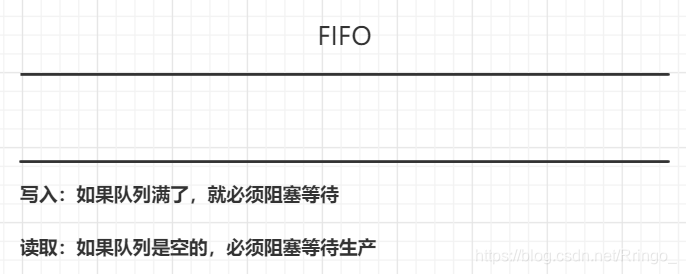
阻塞队列UML图
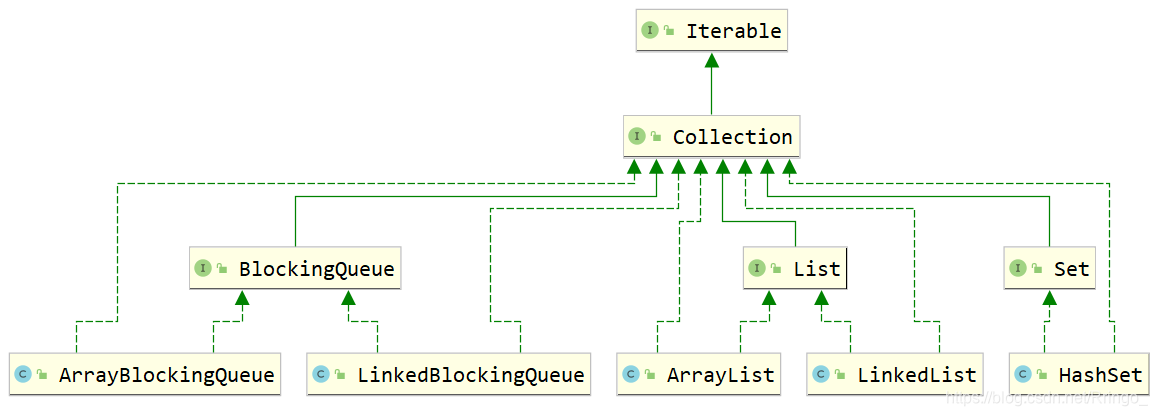
什么情况下会使用阻塞队列:多线程并发处理,线程池!
阻塞队列四组API
| 方式 | 抛出异常 | 有返回值,不抛出异常 | 阻塞等待 | 超时等待 |
|---|---|---|---|---|
| 添加 | add() | offer() | put() | offer() |
| 移除 | remove() | poll() | take() | poll() |
| 查看队首元素 | element() | peek() |
/**
* 抛出异常
*/
public static void test1() {
// 阻塞队列的大小为3
BlockingQueue<Integer> blockingQueue = new ArrayBlockingQueue<>(3);
// 添加
System.out.println(blockingQueue.add(1)); // true
System.out.println(blockingQueue.add(2)); // true
System.out.println(blockingQueue.add(3)); // true
// Exception in thread "main" java.lang.IllegalStateException: Queue full
//System.out.println(blockingQueue.add(4));
System.out.println(blockingQueue.element()); // 查看队首元素
System.out.println("**************************************************");
// 移除
System.out.println(blockingQueue.remove()); // 1
System.out.println(blockingQueue.remove()); // 2
System.out.println(blockingQueue.remove()); // 3
// Exception in thread "main" java.util.NoSuchElementException
//System.out.println(blockingQueue.remove());
}
/**
* 不抛出异常,有返回值
*/
public static void test2() {
// 阻塞队列的大小为3
BlockingQueue<Integer> blockingQueue = new ArrayBlockingQueue<>(3);
// 添加
System.out.println(blockingQueue.offer(1)); // true
System.out.println(blockingQueue.offer(2)); // true
System.out.println(blockingQueue.offer(3)); // true
System.out.println(blockingQueue.offer(4)); // false
System.out.println("****************************************");
// 移除
System.out.println(blockingQueue.poll()); // 1
System.out.println(blockingQueue.poll()); // 2
System.out.println(blockingQueue.peek()); // 查看队首元素 3
System.out.println(blockingQueue.poll()); // 3
System.out.println(blockingQueue.poll()); // null
}
/**
* 阻塞等待(一直阻塞)
*/
public static void test3() throws InterruptedException {
// 阻塞队列的大小为3
BlockingQueue<Integer> blockingQueue = new ArrayBlockingQueue<>(3);
// 添加
blockingQueue.put(1);
blockingQueue.put(2);
blockingQueue.put(3);
//blockingQueue.put(4); // 会一直阻塞等待
System.out.println(blockingQueue.take()); // 1
System.out.println(blockingQueue.take()); // 2
System.out.println(blockingQueue.take()); // 3
System.out.println(blockingQueue.take()); // 一直阻塞等待
}
/**
* 超时等待(过时不候)
*/
public static void test4() throws InterruptedException {
// 阻塞队列的大小为3
BlockingQueue<Integer> blockingQueue = new ArrayBlockingQueue<>(3);
// 添加
System.out.println(blockingQueue.offer(1, 5, TimeUnit.SECONDS));
System.out.println(blockingQueue.offer(2, 5, TimeUnit.SECONDS));
System.out.println(blockingQueue.offer(3, 5, TimeUnit.SECONDS));
// 阻塞队列满了 等5s,如果还在阻塞就放弃本次添加
System.out.println(blockingQueue.offer(4, 5, TimeUnit.SECONDS));
// 移除
System.out.println(blockingQueue.poll(5, TimeUnit.SECONDS));
System.out.println(blockingQueue.poll(5, TimeUnit.SECONDS));
System.out.println(blockingQueue.poll(5, TimeUnit.SECONDS));
// 阻塞队列空了 等5S,如果还在阻塞就放弃本次移除
System.out.println(blockingQueue.poll(5, TimeUnit.SECONDS));
}
8.2.SynchronousQueue
SynchronousQueue同步队列,进去一个元素,必须等待取出来之后,才能往里面再放一个元素。最多只能放一个元素!
package com.ymy;
import java.util.concurrent.BlockingQueue;
import java.util.concurrent.SynchronousQueue;
import java.util.concurrent.TimeUnit;
/**
* 同步队列
* T1线程向同步队列中放元素,必须等T2线程取出元素,T1线程才能继续放元素。
*/
public class SynchronousQueueDemo {
public static void main(String[] args) {
BlockingQueue<Integer> synchronousQueue = new SynchronousQueue<>();
new Thread(() -> {
try {
System.out.println(Thread.currentThread().getName() + "\t put 1");
synchronousQueue.put(1);
System.out.println(Thread.currentThread().getName() + "\t put 2");
synchronousQueue.put(2);
System.out.println(Thread.currentThread().getName() + "\t put 3");
synchronousQueue.put(3);
} catch (InterruptedException e) {
e.printStackTrace();
}
}, "T1").start();
new Thread(() -> {
try {
TimeUnit.SECONDS.sleep(3);
System.out.println(Thread.currentThread().getName() + "\t take \t" + synchronousQueue.take());
TimeUnit.SECONDS.sleep(3);
System.out.println(Thread.currentThread().getName() + "\t take \t" + synchronousQueue.take());
TimeUnit.SECONDS.sleep(3);
System.out.println(Thread.currentThread().getName() + "\t take \t" + synchronousQueue.take());
} catch (InterruptedException e) {
e.printStackTrace();
}
}, "T2").start();
}
}
9.线程池
9.1.线程池介绍
在一个应用程序中,我们需要多次使用线程,也就意味着,我们需要多次创建并销毁线程。而创建并销毁线程的过程势必会消耗内存。而在Java中,内存资源是及其宝贵的,所以,我们就提出了线程池的概念。
线程池的好处:
- 降低系统资源消耗。通过重用已存在的线程,降低线程创建和销毁造成的消耗。
- 提高响应速度。当有任务到达时,通过复用已存在的线程,无需等待新线程的创建便能立即执行。
- 方便线程并发数的管控。
9.2.三大方法

package com.ymy.pool;
import java.util.concurrent.ExecutorService;
import java.util.concurrent.Executors;
/**
* Executors 工具类 三大方法
* 1.一池一线程
* Executors.newSingleThreadExecutor();
* <p>
* 2. 一池固定线程
* Executors.newFixedThreadPool(5);
* <p>
* 3. 一池多线程(可伸缩的,遇强则强,遇弱则弱)
* Executors.newCachedThreadPool();
*/
public class Demo01 {
public static void main(String[] args) {
ExecutorService threadPool = Executors.newCachedThreadPool();
try {
for (int i = 1; i <= 1000; i++) {
// 使用了线程池之后,使用线程池来创建线程!
threadPool.execute(() -> System.out.println(Thread.currentThread().getName()));
}
} finally {
// 程序结束要关闭线程池
threadPool.shutdown();
}
}
}
9.3.七大参数
创建线程池的底层使用的是ThreadPoolExecutor
// SingleThreadPool 一池一线程
public static ExecutorService newSingleThreadExecutor() {
return new FinalizableDelegatedExecutorService
(new ThreadPoolExecutor(1, 1,0L, TimeUnit.MILLISECONDS,new LinkedBlockingQueue<Runnable>()));
}
// FixedThreadPool 一池固定线程
public static ExecutorService newFixedThreadPool(int nThreads) {
return new ThreadPoolExecutor(nThreads, nThreads,0L, TimeUnit.MILLISECONDS,
new LinkedBlockingQueue<Runnable>());
}
// CachedThreadPool 一池多线程(线程数量可以伸缩)
public static ExecutorService newCachedThreadPool() {
return new ThreadPoolExecutor(0, Integer.MAX_VALUE,60L, TimeUnit.SECONDS,
new SynchronousQueue<Runnable>());
}
ThreadPoolExecutor
public ThreadPoolExecutor(int corePoolSize, // 核心线程池大小
int maximumPoolSize, // 最大核心线程池大小
long keepAliveTime, // 超时了,没有人调用就会释放
TimeUnit unit, // 超时单位
BlockingQueue<Runnable> workQueue, // 阻塞队列
ThreadFactory threadFactory, // 线程工厂,创建线程,一般不动
RejectedExecutionHandler handler // 拒绝策略) {
if (corePoolSize < 0 ||
maximumPoolSize <= 0 ||
maximumPoolSize < corePoolSize ||
keepAliveTime < 0)
throw new IllegalArgumentException();
if (workQueue == null || threadFactory == null || handler == null)
throw new NullPointerException();
this.acc = System.getSecurityManager() == null ?
null :
AccessController.getContext();
this.corePoolSize = corePoolSize;
this.maximumPoolSize = maximumPoolSize;
this.workQueue = workQueue;
this.keepAliveTime = unit.toNanos(keepAliveTime);
this.threadFactory = threadFactory;
this.handler = handler;
}
银行办理业务模拟线程池
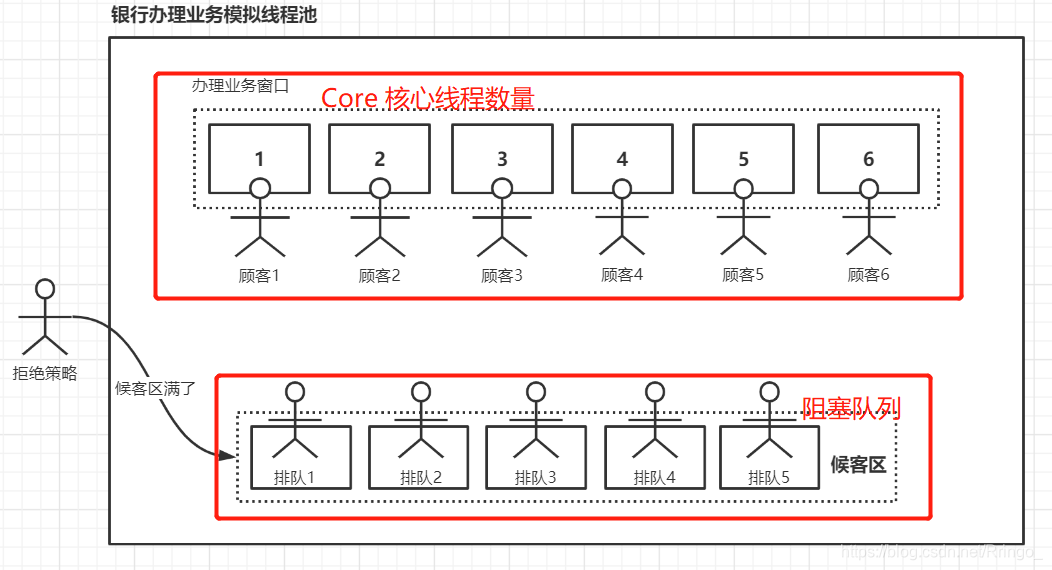
手动创建线程池
new ThreadPoolExecutor(5, 10, 5L, TimeUnit.SECONDS,new ArrayBlockingQueue<Runnable>(3), Executors.defaultThreadFactory(), new ThreadPoolExecutor.AbortPolicy());
9.4.四种拒绝策略
1、ThreadPoolExecutor.AbortPolicy:丢弃任务并抛出RejectedExecutionException异常。
/**
* A handler for rejected tasks that throws a
* {@code RejectedExecutionException}.
*/
public static class AbortPolicy implements RejectedExecutionHandler {
/**
* Creates an {@code AbortPolicy}.
*/
public AbortPolicy() { }
/**
* Always throws RejectedExecutionException.
*
* @param r the runnable task requested to be executed
* @param e the executor attempting to execute this task
* @throws RejectedExecutionException always
*/
public void rejectedExecution(Runnable r, ThreadPoolExecutor e) {
throw new RejectedExecutionException("Task " + r.toString() +
" rejected from " +
e.toString());
}
}
2、ThreadPoolExecutor.DiscardPolicy:丢弃任务,但是不抛出异常。
/**
* A handler for rejected tasks that silently discards the
* rejected task.
*/
public static class DiscardPolicy implements RejectedExecutionHandler {
/**
* Creates a {@code DiscardPolicy}.
*/
public DiscardPolicy() { }
/**
* Does nothing, which has the effect of discarding task r.
*
* @param r the runnable task requested to be executed
* @param e the executor attempting to execute this task
*/
public void rejectedExecution(Runnable r, ThreadPoolExecutor e) {
}
}
3、ThreadPoolExecutor.CallerRunsPolicy:由调用线程(提交任务的线程)处理该任务
/**
* A handler for rejected tasks that runs the rejected task
* directly in the calling thread of the {@code execute} method,
* unless the executor has been shut down, in which case the task
* is discarded.
*/
public static class CallerRunsPolicy implements RejectedExecutionHandler {
/**
* Creates a {@code CallerRunsPolicy}.
*/
public CallerRunsPolicy() { }
/**
* Executes task r in the caller's thread, unless the executor
* has been shut down, in which case the task is discarded.
*
* @param r the runnable task requested to be executed
* @param e the executor attempting to execute this task
*/
public void rejectedExecution(Runnable r, ThreadPoolExecutor e) {
if (!e.isShutdown()) {
r.run();
}
}
}
4、ThreadPoolExecutor.DiscardOldestPolicy:丢弃队列最前面的任务,然后重新提交被拒绝的任务
/**
* A handler for rejected tasks that discards the oldest unhandled
* request and then retries {@code execute}, unless the executor
* is shut down, in which case the task is discarded.
*/
public static class DiscardOldestPolicy implements RejectedExecutionHandler {
/**
* Creates a {@code DiscardOldestPolicy} for the given executor.
*/
public DiscardOldestPolicy() { }
/**
* Obtains and ignores the next task that the executor
* would otherwise execute, if one is immediately available,
* and then retries execution of task r, unless the executor
* is shut down, in which case task r is instead discarded.
*
* @param r the runnable task requested to be executed
* @param e the executor attempting to execute this task
*/
public void rejectedExecution(Runnable r, ThreadPoolExecutor e) {
if (!e.isShutdown()) {
e.getQueue().poll();
e.execute(r);
}
}
}
9.5.小结
最大线程到底该如何定义:
1、CPU密集型,电脑是几核,就是几,可以保证CPU的效率最高。
// 获得处理器的核数
Runtime.getRuntime().availableProcessors()
2、IO密集型,> 判断程序中十分耗IO的线程有多少个
10.四大函数式接口
10.1.函数式接口
函数式接口:只有一个方法的接口
@FunctionalInterface
public interface Runnable {
public abstract void run();
}
// @FunctionalInterface 指明这是函数式接口
// 函数式接口可以简化代码
代码测试
// Function接口
@FunctionalInterface
public interface Function<T, R> {
R apply(T t);
}
/**
* Function 函数型接口,有输入参数,有输出。
* 只要是函数型接口,可以用lambda表达式简写。
*/
public class Demo01 {
public static void main(String[] args) {
Function<String, String> function = str -> str;
System.out.println(function.apply("Tangs"));
}
}
10.2.断定型接口
断定型接口:有一个输入参数,返回值为布尔值。
@FunctionalInterface
public interface Predicate<T> {
boolean test(T t);
}
代码测试
/**
* 断定型接口:有一个输入参数,返回值为布尔值。
*/
public class Demo02 {
public static void main(String[] args) {
// 判断字符串是否为空
Predicate<String> predicate = str -> {
return str.isEmpty();
};
String name = "";
System.out.println(predicate.test(name)); // true 字符串为空
}
}
10.3.消费型接口
消费型接口:只有输入参数,没有返回值
@FunctionalInterface
public interface Consumer<T> {
void accept(T t);
}
代码测试
/**
* 消费型接口:只有输入参数,没有返回值。
*/
public class Demo03 {
public static void main(String[] args) {
Consumer<String> consumer = str -> System.out.println(str);
consumer.accept("Tangs");
}
}
10.4.供给型接口
供给型接口:没有输入参数,只有返回值。
@FunctionalInterface
public interface Supplier<T> {
T get();
}
代码测试
/**
* 供给型接口:没有输入参数,只有返回值!
*/
public class Demo4 {
public static void main(String[] args) {
Supplier<String> supplier = () -> "Tangs";
System.out.println(supplier.get()); // Tangs
}
}
11.Stream流式计算
什么是stream流式计算?
大数据:存储 + 计算。
集合、MySQL本质就是存储东西的;计算都应该交给流来操作!
代码示例
package com.ymy.stream;
import com.ymy.User;
import java.util.Arrays;
import java.util.List;
/**
* 题目要求:一分钟内完成此题,只能用一行代码来实现!
* 现在有5个用户!筛选:
* 1、ID必须是偶数
* 2、年龄必须大于10岁
* 3、用户名转成大写字母
* 4、用户名字母倒着排序
* 5、只输出一个用户
* filter(Predicate<? super T> predicate); 断定型接口
* Stream<R> map(Function<? super T, ? extends R> mapper); 函数型接口
* sorted(Comparator<? super T> comparator); 函数式接口
*/
public class StreamDemo {
public static void main(String[] args) {
User user1 = new User(1, "Tangs", 18);
User user2 = new User(2, "Ringo", 19);
User user3 = new User(3, "Jack", 17);
User user4 = new User(4, "Tom", 14);
User user5 = new User(5, "Smith", 21);
List<User> users = Arrays.asList(user1, user2, user3, user4, user5);
users.stream()
.filter(user -> user.getId() % 2 == 0)
.filter(user -> user.getAge() > 10)
.map(user -> user.getName().toUpperCase())
.sorted((name1, name2) -> name2.compareTo(name1))
.forEach(System.out::println); // TOM RINGO
}
}
12.ForkJoin
12.1.什么是ForkJoin?
ForkJoin在JDK1.7就有了,并行执行任务,提高效率。大数据量!
大数据:Map、Reduce(把大任务拆分为小任务)。
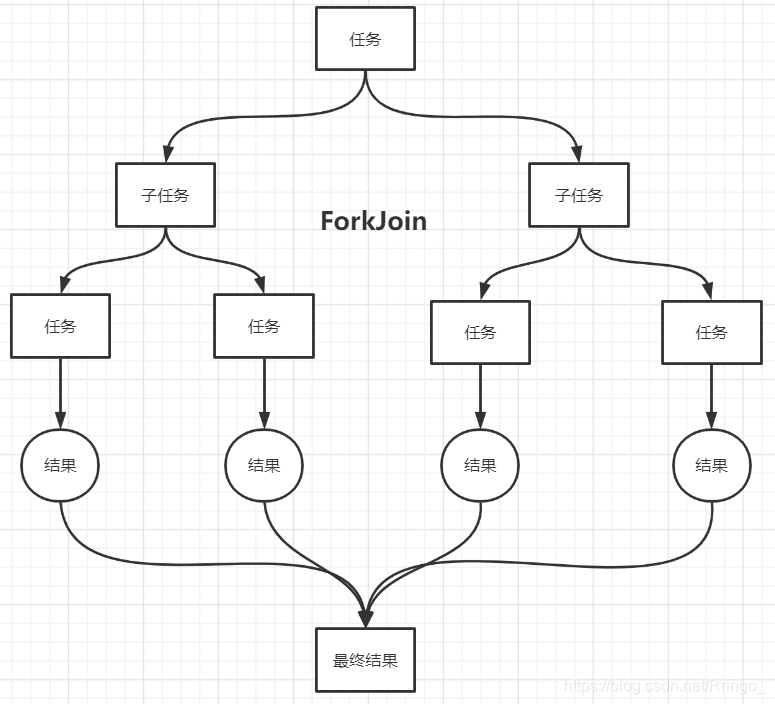
ForkJoin特点:工作窃取!(能者多劳)
这个里面维护的都是双端队列。
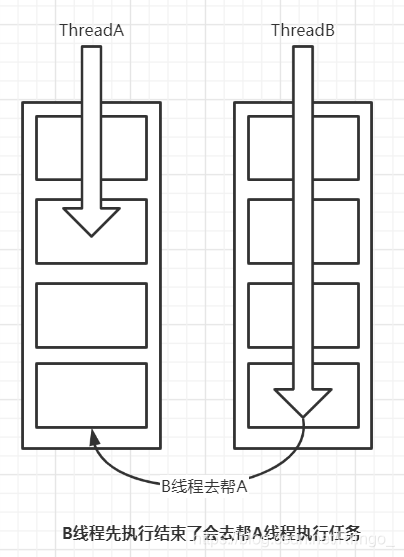
12.2.ForkJoin的使用
创建ForkJoinTask
package com.ymy;
import java.util.concurrent.RecursiveTask;
public class MyRecursiveTask extends RecursiveTask<Long> {
private Long start;
private Long end;
private Long threshold = 10_0000L;
public MyRecursiveTask(Long start, Long end) {
this.start = start;
this.end = end;
}
@Override
protected Long compute() {
if ((end - start) < threshold) {
Long sum = 0L;
for (Long i = start; i <= end; i++) {
sum += i;
}
return sum;
} else {
Long middle = (start + end) >>> 1;
// System.out.println("middle=" + middle);
MyRecursiveTask task1 = new MyRecursiveTask(start, middle);
MyRecursiveTask task2 = new MyRecursiveTask(middle + 1, end);
task1.fork();
task2.fork();
return task1.join() + task2.join();
}
}
}
测试
package com.ymy;
import java.util.concurrent.ForkJoinPool;
public class ForkJoinTest {
public static void main(String[] args) throws Exception {
long start = System.currentTimeMillis();
Long ret = test1(1L, 10_0000_0000L);
long end = System.currentTimeMillis();
System.out.println("ret = " + ret); // 500000000500000000
System.out.println("time = " + (end - start)); // 5396ms
}
/**
* ForkJoin
*/
public static Long test1(Long start, Long end) throws Exception {
MyRecursiveTask task = new MyRecursiveTask(start, end);
// 创建ForkJoinPool
ForkJoinPool forkJoinPool = new ForkJoinPool();
// 提交ForkJoinTask
return forkJoinPool.submit(task).get();
}
}
13.异步回调
package com.ymy.future;
import java.util.concurrent.CompletableFuture;
import java.util.concurrent.ExecutionException;
import java.util.concurrent.TimeUnit;
/**
* 异步调用:CompletableFuture
* 异步执行
* 成功回调
* 失败回调
*/
public class Demo01 {
public static void main(String[] args) throws Exception {
// 没有返回值的异步回调
CompletableFuture<Void> completableFuture = CompletableFuture.runAsync(() -> {
try {
TimeUnit.SECONDS.sleep(2);
} catch (Exception e) {
e.printStackTrace();
}
System.out.println(Thread.currentThread().getName());
});
System.out.println("11111111111111");
completableFuture.get(); // 获取阻塞执行结果
System.out.println("=============================================================");
// 有返回的异步回调
CompletableFuture<Integer> integerCompletableFuture = CompletableFuture.supplyAsync(() -> {
System.out.println(Thread.currentThread().getName());
int i = 1 / 0;
return 1024;
});
System.out.println(integerCompletableFuture.whenComplete((param1, param2) -> {
System.out.println("param1 " + param1); // 正常的返回结果
System.out.println("param2 " + param2); // 错误信息
}).exceptionally(e -> {
System.out.println(e.getMessage());
return 233; // 可以获取到错误的返回结果
}).get());
}
}
14.JMM
请你谈谈対volatile的理解
volatile是Java虚拟机提供的轻量级的同步机制。
1、保证可见性。
2、不保证原子性。
3、禁止指令重排。
什么是JMM?
JMM:Java线程共享内存模型,不存在的东西,概念!约定!
关于JMM的一些同步的约定:
1、线程解锁前,必须把共享变量立刻刷新回主物理内存。
2、线程加锁前,必须读取主物理内存中的最新的值到工作内存中。
3、加锁和解锁是同一把锁。
Java共享内存模型的8种操作
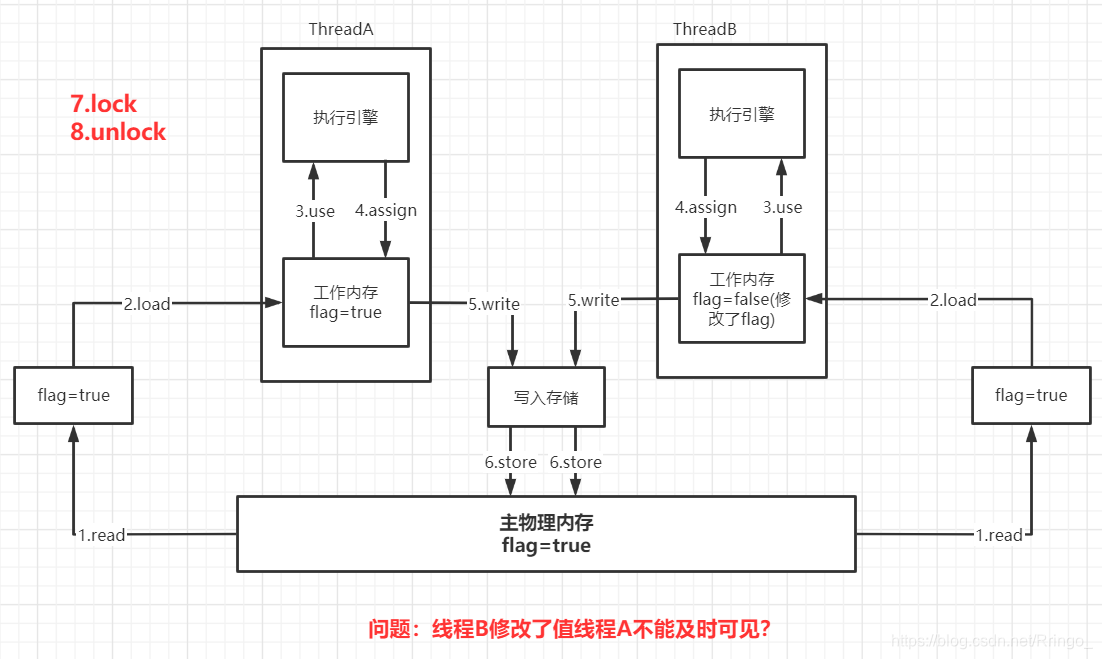
关于主内存与工作内存之间的交互协议,即一个变量如何从主内存拷贝到工作内存。如何从工作内存同步到主内存中的实现细节。java内存模型定义了8种操作来完成。这8种操作每一种都是原子操作。8种操作如下:
- lock(锁定):作用于主内存,它把一个变量标记为一条线程独占状态;
- read(读取):作用于主内存,它把变量值从主内存传送到线程的工作内存中,以便随后的load动作使用;
- load(载入):作用于工作内存,它把read操作的值放入工作内存中的变量副本中;
- use(使用):作用于工作内存,它把工作内存中的值传递给执行引擎,每当虚拟机遇到一个需要使用这个变量的指令时候,将会执行这个动作;
- assign(赋值):作用于工作内存,它把从执行引擎获取的值赋值给工作内存中的变量,每当虚拟机遇到一个给变量赋值的指令时候,执行该操作;
- store(存储):作用于工作内存,它把工作内存中的一个变量传送给主内存中,以备随后的write操作使用;
- write(写入):作用于主内存,它把store传送值放到主内存中的变量中。
- unlock(解锁):作用于主内存,它将一个处于锁定状态的变量释放出来,释放后的变量才能够被其他线程锁定;
Java内存模型还规定了执行上述8种基本操作时必须满足如下规则:
不允许read和load、store和write操作之一单独出现(即不允许一个变量从主存读取了但是工作内存不接受,或者从工作内存发起会写了但是主存不接受的情况),以上两个操作必须按顺序执行,但没有保证必须连续执行,也就是说,read与load之间、store与write之间是可插入其他指令的。
不允许一个线程丢弃它的最近的assign操作,即变量在工作内存中改变了之后必须把该变化同步回主内存。
不允许一个线程无原因地(没有发生过任何assign操作)把数据从线程的工作内存同步回主内存中。
一个新的变量只能从主内存中“诞生”,不允许在工作内存中直接使用一个未被初始化(load或assign)的变量,换句话说就是对一个变量实施use和store操作之前,必须先执行过了assign和load操作。
一个变量在同一个时刻只允许一条线程对其执行lock操作,但lock操作可以被同一个条线程重复执行多次,多次执行lock后,只有执行相同次数的unlock操作,变量才会被解锁。
如果对一个变量执行lock操作,将会清空工作内存中此变量的值,在执行引擎使用这个变量前,需要重新执行load或assign操作初始化变量的值。
如果一个变量实现没有被lock操作锁定,则不允许对它执行unlock操作,也不允许去unlock一个被其他线程锁定的变量。
对一个变量执行unlock操作之前,必须先把此变量同步回主内存(执行store和write操作)。
15.volatile
1、保证可见性
package com.ymy.volat;
import java.util.concurrent.TimeUnit;
/**
* 测试可见性
* 如果变量num不加volatile,那么当main线程修改了num的值,
* A线程还是会一直执行循环,加上volatile,当num被其他线程
* 修改后,A线程会去重新读num的值,从而推出循环!
*/
public class Demo01 {
public volatile static int num = 0;
public static void main(String[] args) throws Exception {
new Thread(() -> {
while (num == 0) {
}
}, "A").start();
TimeUnit.SECONDS.sleep(3);
num = 1;
System.out.println(num);
}
}
2、不保证原子性
原子性:不可分割!线程A在执行任务的时候,是不能被打扰的,也不能被分割,要么同时成功,要么同时失败。
package com.ymy.volat;
/**
* 测试不保证原子性
*/
public class Demo02 {
private volatile static int num = 0;
public static void add() {
num++;
}
public static void main(String[] args) {
// 理论上执行完num应该为20000
for (int i = 1; i <= 20; i++) {
new Thread(() -> {
for (int j = 1; j <= 1000; j++) {
add();
}
}).start();
}
while (Thread.activeCount() > 2) {
Thread.yield();
}
System.out.println(Thread.currentThread().getName() + "\t" + num); // 实际上num小于20000
}
}
3、禁止指令重排
指令重排:写的Java程序,计算机并不是按照我们写的那样去执行的。
处理器在进行指令重排的时候,考虑:数据之间的依赖性!
int x = 1; // 1
int y = 2; // 2
x = x + 5; // 3
y = x * x; // 4
我们期望的执行顺序:1234
但是计算机执行的时候可能是 2143
16.单例模式
懒汉单例DCL
package com.ymy.single;
import java.lang.reflect.Constructor;
/**
* 懒汉单例
*/
public class Lazy {
// 加上volatile禁止指令重排
private volatile static Lazy lazy = null;
private Lazy() {
}
// 双重检测 DCL懒汉式
public static Lazy getInstance() {
if (lazy == null) {
synchronized (Lazy.class) {
if (lazy == null) {
lazy = new Lazy();
}
}
}
return lazy;
}
// 反射
public static void main(String[] args) throws Exception{
// 创建一个实例
Lazy instance1 = Lazy.getInstance();
// 拿到无参构造器去创建对象
Constructor<Lazy> declaredConstructor = Lazy.class.getDeclaredConstructor(null);
declaredConstructor.setAccessible(true);
Lazy instance2 = declaredConstructor.newInstance();
System.out.println(instance1 == instance2); // false
}
}
静态内部类
package com.ymy.single;
/**
* 静态内部类
*/
public class Holder {
private Holder() {
}
private static class InnerClass {
private static Holder holder = new Holder();
}
public static Holder getInstance() {
return InnerClass.holder;
}
public static void main(String[] args) {
}
}
枚举单例
package com.ymy.single;
import java.lang.reflect.Constructor;
public enum EnumSingle {
INSTANCE;
public static EnumSingle getInstance() {
return INSTANCE;
}
}
// 测试反射!
class Test {
public static void main(String[] args) throws Exception {
EnumSingle instance1 = EnumSingle.getInstance();
Constructor<EnumSingle> declaredConstructor = EnumSingle.class.getDeclaredConstructor(String.class, int.class);
declaredConstructor.setAccessible(true);
// java.lang.IllegalArgumentException: Cannot reflectively create enum objects
EnumSingle instance2 = declaredConstructor.newInstance();
System.out.println(instance1 == instance2);
}
}
17.CAS
AtomicInteger这个原子类引入了Unsafe类。
public class AtomicInteger extends Number implements java.io.Serializable {
private static final long serialVersionUID = 6214790243416807050L;
// Unsafe类中有大量的native方法,java是无法操作的,要调用底层的C++接口来直接操作内存
// Unsafe类相当于Java的后门,可以通过C++来操作内存
private static final Unsafe unsafe = Unsafe.getUnsafe();
// valueOffset获取内存地址的偏移值
private static final long valueOffset;
// AtomicInteger类保存的具体值,使用volatile保证线程间的可见性,禁止指令重排
private volatile int value;
下面来看AtomicInteger原子类中getAndIncrement()方法。
// AtomicInteger
public final int getAndIncrement() {
return unsafe.getAndAddInt(this, valueOffset, 1);
}
// Unsafe
/**
* var1:当前对象
* var2:地址的偏移量
* var4:需要增加的值
*/
public final int getAndAddInt(Object var1, long var2, int var4) {
int var5;
do {
// 通过当前对象var1和地址偏移量var2获得内存中存储的值var5
var5 = this.getIntVolatile(var1, var2);
/** 如果现在通过var1和地址偏移量var2拿到的值是var5,那么就将(var5 + var4)的值写回内存中
* 并且返回true,直接退出循环,否则就返回false,一直循环。
*/
} while(!this.compareAndSwapInt(var1, var2, var5, var5 + var4));
return var5;
}
public native int getIntVolatile(Object var1, long var2);
public final native boolean compareAndSwapInt(Object var1, long var2, int var4, int var5);
CAS:compareAndSwap比较当前内存中的值和主内存中的值,如果这个值是期望的值,那么就执行操作!否则就一直自旋。
CAS缺点:
- 循环会耗时。
- 一次性只能保证一个共享变量的原子性。
- `ABA问题。
18.原子引用ABA问题
什么是ABA问题?一句话:ABA问题就是狸猫换太子。
假设有一条记录Record1,Thread-A去修改了这条记录,把Record1修改成了Record2,过了一会儿Thread-A又把Record2修改了Record1,然后Thread-A就执行结束了。接着Thread-B来修改记录,Thread-B期望内存中存储的记录是Record1,这时候内存中存储的记录也确实是Record1,于是Thread-B就将Record1修改成了Record3,实际上这种操作是有问题的!这就是原子引用的ABA问题!
package com.ymy.cas;
import lombok.AllArgsConstructor;
import lombok.Data;
import lombok.NoArgsConstructor;
import java.util.concurrent.TimeUnit;
import java.util.concurrent.atomic.AtomicReference;
/**
* ABA问题测试代码
*/
public class ABADemo {
public static void main(String[] args) throws Exception {
Record record1 = new Record(1, "第一次提交");
AtomicReference<Record> recordAtomicReference = new AtomicReference<>(record1);
Record record2 = new Record(2, "A线程修改记录");
Record record3 = new Record(3, "B线程修改记录");
new Thread(() -> {
System.out.println(Thread.currentThread().getName() + "\t" + "修改记录...");
// A线程将record1修改为了record2
recordAtomicReference.compareAndSet(record1, record2);
try {
TimeUnit.SECONDS.sleep(2);
} catch (Exception e) {
e.printStackTrace();
}
// A线程又将record2修改成了record1
recordAtomicReference.compareAndSet(record2, record1);
}, "A").start();
TimeUnit.SECONDS.sleep(3);
new Thread(() -> {
System.out.println(Thread.currentThread().getName() + "\t" + "修改记录...");
// B线程又去修改记录,期望的值是record1,B线程以为,A线程没有被其他线程修改!
// 实际上该记录已经被A线程修改了,这就是ABA问题
recordAtomicReference.compareAndSet(record1, record3);
}, "B").start();
while (Thread.activeCount() > 2) {
// main线程放弃CPU的执行权
Thread.yield();
}
System.out.println(recordAtomicReference.get()); // Record(id=3, content=B线程修改记录)
}
}
/**
* Record:封装记录
*/
@Data
@NoArgsConstructor
@AllArgsConstructor
class Record {
private Integer id;
private String content;
}
那么ABA问题有什么解决办法呢???
使用AtomicStampedReference来添加时间戳(版本号)来解决ABA问题。
package com.ymy.cas;
import lombok.AllArgsConstructor;
import lombok.Data;
import lombok.NoArgsConstructor;
import java.util.concurrent.TimeUnit;
import java.util.concurrent.atomic.AtomicStampedReference;
/**
* AtomicStampedReference解决ABA问题测试代码
*/
public class ABADemo {
public static void main(String[] args) throws Exception {
Record record1 = new Record(1, "第一次提交");
// AtomicStampedReference(V initialRef, int initialStamp)
AtomicStampedReference<Record> recordAtomicStampedReference = new AtomicStampedReference<>(record1, 1);
Record record2 = new Record(2, "A线程修改记录");
Record record3 = new Record(3, "B线程修改记录");
new Thread(() -> {
System.out.println(Thread.currentThread().getName() + "\t" + "修改记录...");
/* compareAndSet(V expectedReference,
V newReference,
int expectedStamp,
int newStamp)
*/
// A线程将record1修改为了record2
recordAtomicStampedReference.compareAndSet(record1, record2, 1, 2);
try {
TimeUnit.SECONDS.sleep(2);
} catch (Exception e) {
e.printStackTrace();
}
// A线程又将record2修改成了record1
recordAtomicStampedReference.compareAndSet(record2, record1, 2, 3);
}, "A").start();
TimeUnit.SECONDS.sleep(3);
new Thread(() -> {
System.out.println(Thread.currentThread().getName() + "\t" + "修改记录...");
// 如果时间戳(版本号)被修改了就证明之前有其他线程修改了记录,B线程需要重新从内存中读取到最新的记录才可以修改
recordAtomicStampedReference.compareAndSet(record1, record3, 1, 2);
}, "B").start();
while (Thread.activeCount() > 2) {
// main线程放弃CPU的执行权
Thread.yield();
}
System.out.println(recordAtomicStampedReference.getReference()); // Record(id=1, content=第一次提交)
System.out.println(recordAtomicStampedReference.getStamp()); // 3 version的初始值是1被A线程修改两次后变成3 B线程没有修改记录
}
}
/**
* Record:封装记录
*/
@Data
@NoArgsConstructor
@AllArgsConstructor
class Record {
private Integer id;
private String content;
}
19.各种锁的理解
19.1.公平锁和非公平锁
- 公平锁:非常公平,不能够插队,来了就排队,必须先来后来。
- 非公共锁:非常不公平,可以插队,后面来的线程只要抢到锁就可以占有资源(默认都是非公平锁)。
// ReentrantLock 默认就是非公平锁
public ReentrantLock() {
sync = new NonfairSync();
}
// 可以将ReentrantLock 默认的非公平锁修改为公平锁
public ReentrantLock(boolean fair) {
sync = fair ? new FairSync() : new NonfairSync();
}
19.2.可重入锁
可重入锁(递归锁):可重入就是说某个线程已经获得某个锁,可以再次获取相同的锁而不会出现死锁。
Synchronized版本
package com.ymy.reentant;
/**
* 可重入锁(递归锁):可重入就是说某个线程已经获得某个锁,
* 可以再次获取相同的锁而不会出现死锁。
*
* 程序执行结果:
* A sms...
* A call...
* B call...
*/
public class ReentrantDemo01 {
public static void main(String[] args) {
Phone phone = new Phone();
new Thread(() -> {
phone.sms();
}, "A").start();
new Thread(() -> {
phone.call();
}, "B").start();
}
}
/**
* sms() 和 call()两个方法的synchronized锁的都是当前Phone实例
*/
class Phone {
public synchronized void sms() {
System.out.println(Thread.currentThread().getName() + "\t" + "sms...");
call();
}
public synchronized void call() {
System.out.println(Thread.currentThread().getName() + "\t" + "call...");
}
}
当Thread-A调用sms()方法获得Phone的对象锁时,由于sms()方法还没有执行完又调用call()方法,恰好sms()和call()都是同一把锁,Thread-A就不用再去获取锁了,直接就可以进入到call()方法中!!!
Lock版本
package com.ymy.reentant;
import java.util.concurrent.locks.Lock;
import java.util.concurrent.locks.ReentrantLock;
/**
* Lock锁和Synchronized锁的区别:lock和unlock必须成对出现,否则就会造成死锁
* <p>
* 程序运行结果:
* A sms()...
* A call()...
* B call()...
*/
public class ReentrantDemo02 {
public static void main(String[] args) {
Iphone iphone = new Iphone();
new Thread(() -> {
iphone.sms();
}, "A").start();
new Thread(() -> {
iphone.call();
}, "B").start();
}
}
class Iphone {
private Lock lock = new ReentrantLock();
public void sms() {
lock.lock();
lock.lock(); //如果这里lock两次,finally中只unlock一次,就会造成死锁
try {
System.out.println(Thread.currentThread().getName() + "\t" + "sms()...");
call();
} finally {
lock.unlock();
lock.unlock();
}
}
public void call() {
lock.lock();
try {
System.out.println(Thread.currentThread().getName() + "\t" + "call()...");
} finally {
lock.unlock();
}
}
}
Lock锁很灵活,需要手动加锁lock(),也需要手动解锁unlock(),如果lock()和unlock()不是成对出现的就会造成死锁。在sms()方法中,lock()和unlock()对应上锁和释放锁的是sms()方法;在call()方法中,lock()和unlock()对应上锁和释放锁的是call()方法,虽然sms()方法中调用了call()方法,但是两个方法中的lock()和unlock()一样不能混淆!!!
20.死锁排查
什么是死锁?
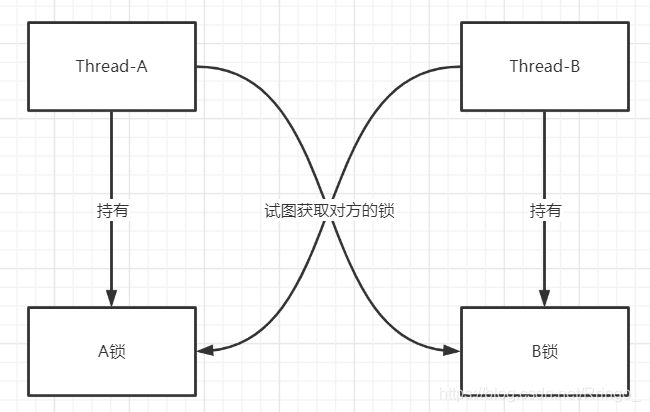
死锁:指两个或两个以上的进程在执行过程中,由于竞争资源或者由于彼此通信而造成的一种阻塞的现象,若无外力作用,它们都将无法推进下去。此时称系统处于死锁状态或系统产生了死锁,这些永远在互相等待的进程称为死锁进程。
死锁代码测试
package com.ymy.dead;
import java.util.concurrent.TimeUnit;
/**
* 死锁
*/
public class DeadLockDemo {
public static void main(String[] args) {
Resource1 resource1 = new Resource1();
Resource2 resource2 = new Resource2();
new Thread(() -> {
resource1.getRes();
}, "A").start();
new Thread(() -> {
resource2.getRes();
}, "B").start();
}
}
// 资源类Resource1
class Resource1 {
public void getRes() {
synchronized (Resource1.class) {
System.out.println(Thread.currentThread().getName() + "\t" + "获取到Resource1的锁");
// 设置延迟3S保证Thread-A获得Resource1锁的同时,Thread-B获得Resource2锁
try {
TimeUnit.SECONDS.sleep(3);
} catch (InterruptedException e) {
e.printStackTrace();
}
synchronized (Resource2.class) {
System.out.println(Thread.currentThread().getName() + "\t" + "获取到Resource2的锁");
}
}
}
}
// 资源类Resource2
class Resource2 {
public synchronized void getRes() {
synchronized (Resource2.class) {
System.out.println(Thread.currentThread().getName() + "\t" + "获取到Resource2的锁");
synchronized (Resource1.class) {
System.out.println(Thread.currentThread().getName() + "\t" + "获取到Resource1的锁");
}
}
}
}
死锁的排查
1、使用jps-l定位进程号。
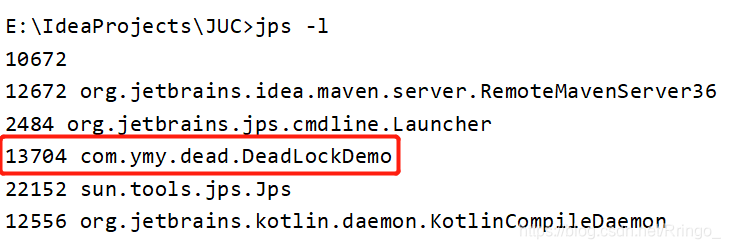
2、使用jstack + 进程号 打印堆栈信息
